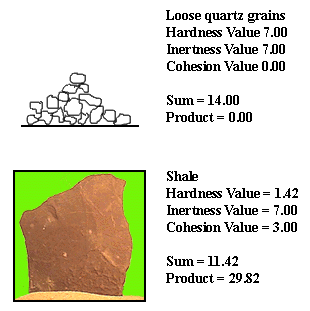- how hard they are
- how chemically reactive they are
- how well their components stick together (cohesion).
What is the relative importance of these three factors (hardness, inertness and cohesion) in determining the resistance to erosion of each of the geologic materials?
To address this question, look at the geologic materials shown on the right. The top picture shows a pile of loose quartz grains. The bottom picture shows the rock 'shale'. The Hardness, Inertness, and Cohesion Values are listed for each.
 Compare shale with loose quartz grains. Which material do you think will be more resistant to erosion?
Compare shale with loose quartz grains. Which material do you think will be more resistant to erosion?
 Is hardness, chemical reactivity or cohesion most important in determining resistance to erosion?
Is hardness, chemical reactivity or cohesion most important in determining resistance to erosion?
 Can you explain your answers to the previous two questions?
Can you explain your answers to the previous two questions?
Your answers to these three questions will control the answers to the next set of questions:
- How can the Hardness, Inertness and Cohesion Values be combined to form an "index" that will express relative resistance to erosion?
- Which of the three 'Values' should be given most weight?
- How may this be accomplished?
The index needs to be designed so that it reflects an important fact: no matter how hard or resistant to chemical attack the components of a material are, if the components are not firmly attached to each other, the resistance to erosion will be low.
For example, quartz grains are very hard and chemically inert. But a loose pile of unattached quartz grains (Cohesion Value = 0) will be easily eroded. If the three values had merely been added to each other to create the Index, the loose pile of quartz grains would have had a higher sum (14.00) than the rock shale (11.42), which is made of attached grains that are chemically inert but that are very soft. Since shale is more resistant to erosion than loose quartz grains, the Index would not reflect the real situation (see picture on the right).
But if the Erosion-Resistance Index is made equal to the product of the Hardness, Inertness and Cohesion Values, then if the Cohesion Value is 0, the Erosion-Resistance Index will also be 0, and will accurately reflect the real situation. Using an index designed in this fashion, the shale (product=29.82) has an index greater than the loose quartz grains (product=0.00).



